Vector-borne Disease
Vector-borne diseases are bacterial and viral diseases transmitted by mosquitoes, ticks and other insects. Some of these diseases have been present in the United States for many years, while others have recently emerged.
Page Navigation
Mosquito-borne diseases
Dengue fever
Dengue is a disease caused by any one of four related viruses, which are transmitted by the bite of an infected Aedes aegypti or Aedes albopictus mosquito. Infection with one of the four viruses does not protect against infection with the others. Consecutive infections put people at greater risk of developing dengue hemorrhagic fever (DHF).
Signs and Symptoms
Symptoms of dengue include:
- High fever
- Severe headache
- Severe eye pain (behind eyes)
- Joint pain
- Muscle and/or bone pain
- Rash
- Mild bleeding (e.g., nose or gums bleed, easy bruising)
- Low white blood cell count
Generally, younger children and those with their first dengue infection have a milder illness than older children and adults.
Watch for warning signs as temperature declines 3 to 7 days after symptoms began.
Go IMMEDIATELY to an emergency room or the closest health care provider if any of the following warning signs appear:
- Severe abdominal pain or persistent vomiting
- Red spots or patches on the skin
- Bleeding from nose or gums
- Vomiting blood
- Black, tarry stools (feces, excrement)
- Drowsiness or irritability
- Pale, cold, or clammy skin
- Difficulty breathing
Where Found
Dengue is not found in Iowa. Nearly all dengue cases reported in the United States were acquired elsewhere by travelers or immigrants. Dengue is commonly found in Asia, the Pacific, the Americas, Africa, and the Caribbean. Click here for more information on Dengue fever.
For more information, visit the CDC Dengue fever webpage.
Malaria
Malaria is a serious and sometimes fatal disease caused by a parasite that commonly infects Anopheles mosquitoes. Malaria is spread to humans by the bite of the infected female mosquito. Only Anopheles mosquitoes can transmit malaria and they must have been infected through a previous blood meal taken from an infected person.
Signs and Symptoms
Malaria can cause fever and flu-like illness. Symptoms include:
- Chills
- Headache
- Muscle aches
- Tiredness
Additional symptoms that may occur:
If Malaria is not treated properly, severe complications and death can occur.
Where Found
Malaria was eliminated from the U.S. in the early 1950's. Cases occurring the U.S. are in travelers and immigrants returning from parts of the world where malaria transmission occurs. Malaria is commonly found in sub-Saharan Africa and South Asia.
For more information, visit the CDC malaria webpage.
Chikungunya
Chikungunya is a viral disease that is spread to people by the bite of an infected Aedes aegypti and Aedes albopictus mosquito. Mosquitoes become infected when they feed on a person already infected with this virus.
Signs and Symptoms
Symptoms usually begin three to seven days after being bitten by an infected mosquito.
Common symptoms include:
- Fever
- Severe joint pain (often in the hands and feet)
Other symptoms can include:
- Headache
- Muscle pain
- Joint swelling
- Rash
Where Found
Chikungunya is not found in Iowa. Cases occurring in Iowa are travelers returning from parts of the world where chikungunya transmission occurs. Prior to 2013, chikungunya outbreaks had been identified in countries in Africa, Asia, Europe, and islands in the Indian and Pacific Oceans. In late 2013, the first local transmission of chikungunya virus in the Americas was first identified in Caribbean countries and territories.
For more information, visit the CDC chikungunya webpage.
La Crosse encephalitis
La Crosse encephalitis virus (LACV) is passed to humans by the bite of an infected Aedes triseriatus mosquito. These mosquitoes are most active during the daytime, especially in or near infested woods.
Signs and Symptoms
Many people who are infected with LACV have no symptoms. Among people who become ill, symptoms include:
- Fever
- Headache
- Nausea
- Vomiting
- Tiredness
Some people infected with LACV may also develop severe disease that affects the nervous system, such as encephalitis (an inflammation of the brain). This severe disease can cause seizures, coma, and paralysis. Severe disease occurs most often in children under the age of 16.
Where Found
Most cases occur in the upper Midwestern, mid-Atlantic, and Southeastern states. LACV is not frequently reported in Iowa.
For more information, visit the CDC La Crosse encephalitis webpage.
Saint Louis encephalitis
Saint Louis encephalitis virus (SLEV) is passed to humans by the bite of an infected Culex species mosquito.
Signs and Symptoms
Most people infected with SLEV have no apparent illness. Symptoms of those who become ill include:
- Fever
- Headache
- Nausea
- Vomiting
- Tiredness
Severe disease (often involving encephalitis, an inflammation of the brain) occurs more often in older adults. In rare cases, long-term disability or death can result from this illness.
Where Found
Most cases of SLEV disease have occurred in the Eastern and Central parts of the United States. SLEV is rarely reported in Iowa.
For more information, visit the CDC SLE webpage.
West Nile virus
West Nile virus is carried by mosquitoes (especially Culex species). West Nile virus (WNV) can cause serious illness in humans and animals.
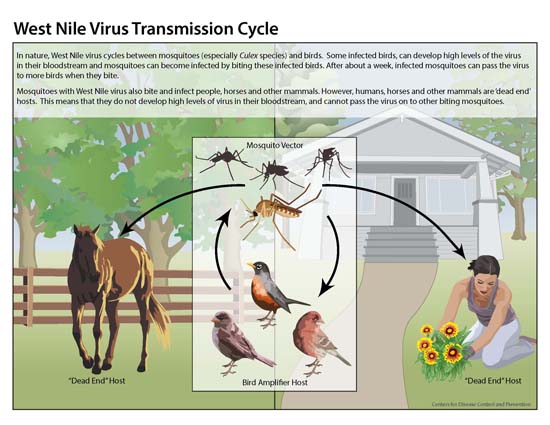
Signs and Symptoms
Most people (70-80%) who become infected with West Nile virus do not develop any symptoms.
About 1 in 5 people who are infected with WNV will develop a fever along with other symptoms such as:
- Headache
- Body aches
- Joint pains
- Vomiting,
- Diarrhea
- Rash
Most people with this type of WNV disease recover completely, however, fatigue and weakness can last for weeks or months.
Less than 1% of people who are infected with WNV will develop a serious neurologic illness, such as encephalitis or meningitis (inflammation of the brain or surrounding tissues). The symptoms of neurologic illness may include:
- Headache
- High fever
- neck stiffness
- Confusion
- Coma
- Tremors
- Seizures
- Vision loss
- Paralysis
Serious illness can occur in people of any age. However, people over 60 years of age are at the greatest risk for severe disease. People with certain medical conditions, such as cancer, diabetes, hypertension, kidney disease, and people who have received organ transplants, are also at greater risk for serious illness. Recovery from severe disease may take several weeks or months. Some of the neurologic effects may be permanent. About 10 percent of people who develop neurologic infection due to West Nile virus will die.
Where Found
West Nile virus (WNV) is a mosquito-borne virus that has been documented in Europe, the Middle East, Africa, India, parts of Asia, Australia, and the Americas. The virus was first identified in the West Nile district of Uganda in 1937. It was first reported in the United States in 1999, when 62 cases and seven deaths from West Nile virus infection were reported in the New York City area. Since 1999, West Nile virus has spread across the continental United States. The first documented virus in Iowa was identified in a dead crow in the eastern part of the state in September 2001. Human cases have been reported every year since 2002 in Iowa.
For more information, visit the IDPH West Nile virus webpage.
Zika virus
Zika primarily spreads through the bite of infected Aedes species mosquito. You can also get Zika through sex with an infected individual. Additionally, a pregnant woman who is already infected with Zika virus can pass it to her fetus during pregnancy or around the time of the child's birth. To date, there have not been any confirmed blood transfusion transmission cases in the United States, however, there have been multiple reports of blood transfusion transmission cases in Brazil.
Signs and Symptoms
Many people infected with Zika virus (about 20%) won’t have any symptoms or will only have mild symptoms. The most common symptoms of Zika include:
- Fever
- Rash
- Joint pain
- Conjunctivitis (red eyes)
- Muscle pain
- Headache
Mild illness with Zika virus usually lasts several days to a week. People usually don’t get sick enough to go to the hospital, and they very rarely die of Zika. For this reason, many people might not realize they have been infected.
Severe disease requiring hospitalization for Zika virus is uncommon. However, as previously mentioned, a pregnant woman can pass Zika virus to her fetus during pregnancy. Zika may cause severe or abnormal brain defects in the fetus.
For more information on Zika virus, visit the CDC Zika virus webpage.
How to reduce risk of mosquito bites
Peak mosquito biting hours are from dusk to dawn. Ways to prevent mosquito bites include the following:
- Wear Environmental Protection Agency (EPA)-registered insect repellents with one of the active ingredients below:
- DEET
- Permethrin (applied to clothing only, should not be used on skin)
- Picaridin
- IR3535
- or oil of lemon eucalyptus.
- Products containing up to 30 percent DEET have been shown to be the most effective and are safe for adults, including pregnant women, and children over 2 months of age.
- Wear light colored, long-sleeved shirts and long pants
- Eliminate standing water where mosquitoes breed (e.g., old tires in the backyard)
- Change water in birdbaths and pet bowls every three to four days to stop mosquitoes from breeding
- Turn over items in your yard where rainwater can collect (e.g., kiddie pools)
- Windows and doors should have tight-fitting screens
- Make sure roof gutters are clean and in good repair
- Repair leaky outdoor faucets, air conditioners, and hoses which may increase standing water around your home where mosquitoes can breed
Mosquito-Borne Disease materials
The following mosquito-borne disease materials are available from CADE by completing the order form.
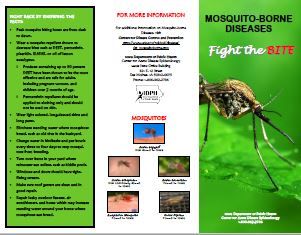
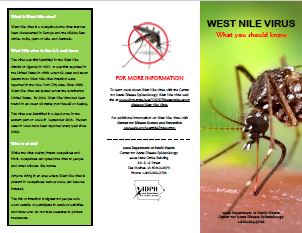
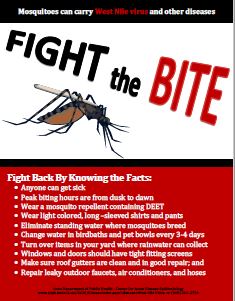
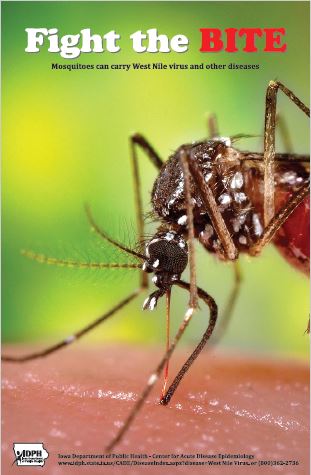
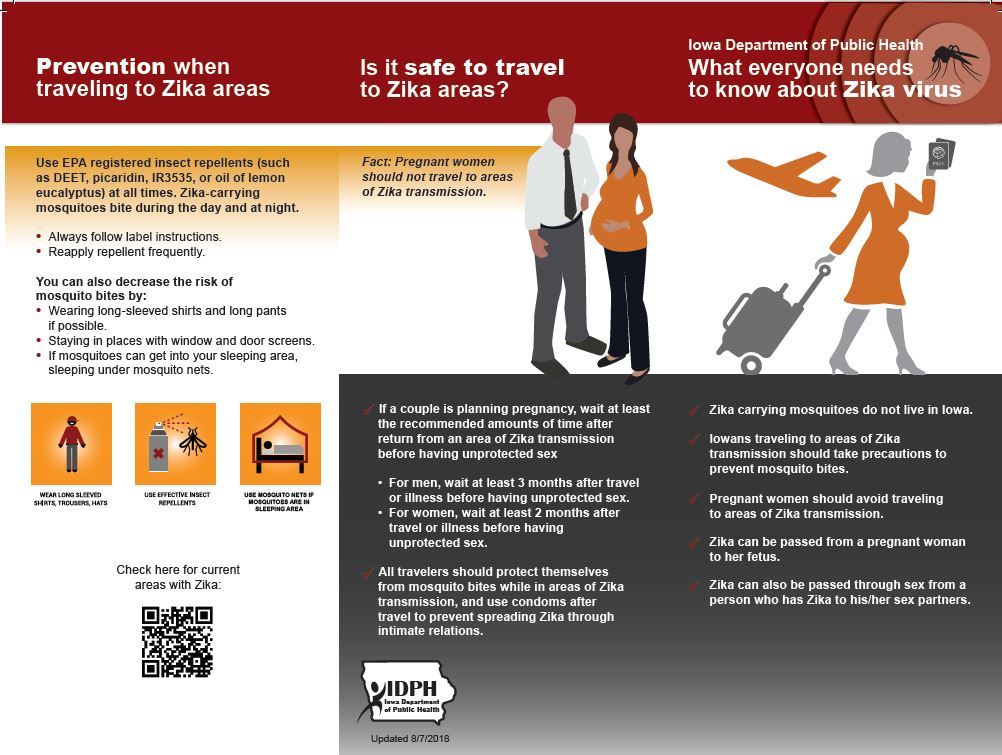 English version / Spanish version
English version / Spanish version
Tick-borne diseases
Most ticks go through four life stages: egg, six-legged larva, eight-legged nymph, and adult. After hatching from the eggs, ticks must eat blood at every stage to survive. Ticks that require this many hosts can take up to 3 years to complete their full life cycle, and most will die because they don’t find a host for their next feeding.
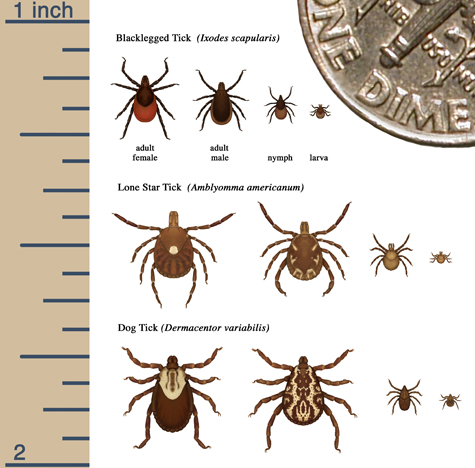
Relative sizes of several ticks at different life stages.
Babesiosis
Babesiosis is caused by microscopic parasites that infect red blood cells. It is spread by certain ticks. In the United States, tickborne transmission of this illness is most common in particular regions and seasons: it mainly occurs in parts of the Northeast and upper Midwest and usually peaks during the warm months.
Signs and Symptoms
Many people who are infected with Babesia do not have symptoms. Symptoms can include
- Fever
- Flu-like symptoms (nausea, chills, body aches, tiredness, etc.)
- Hemolytic anemia (infection of red blood cells)
Where Found

This map is not meant to represent risks for a specific tick-borne disease. Disease transmission for this illnesses is influenced by multiple factors beyond tick presence alone. This map represents the geographic distribution of this species of ticks.
For more information, visit the CDC babesiosis webpage.
Ehrlichiosis/Anaplasmosis
There are at least four species of bacteria responsible for ehrlichiosis/anaplasmosis in the United States: Ehrlichia chaffeensis, Anaplasma phagocytophilum, Ehrlichia ewingii, and Ehrlichia muris-like (EML).. Anaplasmosis is transmitted by black-legged tick and the western black-legged tick. Ehrilichiosis is transmitted by the bite of an infected lone star tick (Amblyomma americanum), which is found in Iowa.
Signs and Symptoms
Symptoms of ehrlichiosis and anaplasmosis are similar and typically occur within 1-2 weeks of a tick bite. Symptoms include:
- Fever
- Headache
- Chills
- Muscle aches
- Tiredness
- Confusion
- Nausea / Vomiting / Diarrhea
- Conjunctivitis (red eyes)
- Rash (in up to 60% of children, less than 30% of adults)
Where Found


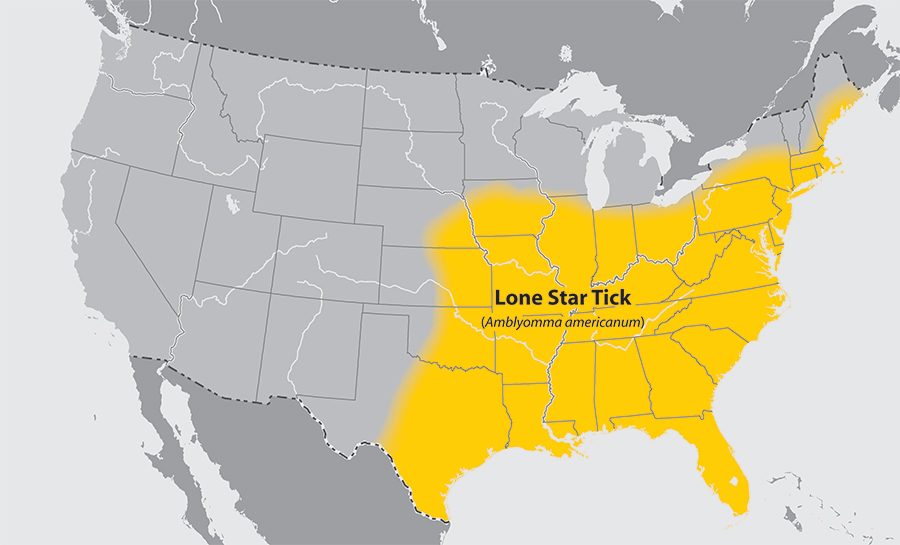
These maps are not meant to represent risks for a specific tick-borne disease. Disease transmission for these illnesses is influenced by multiple factors beyond tick presence alone. This map represents the geographic distribution of these species.
For more information, visit the CDC ehrlichiosis webpage.
For more information, visit the CDC anaplasomosis webpage.
Lyme disease
Lyme disease is caused by Borrelia burgdorferi, and, is transmitted to humans by the bite of an infected tick, primarily Ixodes scapularis (also known as the black legged or deer tick).

This diagram shows the life cycle of blacklegged ticks that can transmit anaplasmosis, babesiosis, and Lyme disease.
Ticks are most likely to spread the Lyme disease bacterium during their pre-adult stage (nymph). Ticks are most active between May and July, and are commonly found in tall grasses and brush of wooded areas in Iowa.
Signs and Symptoms
Early symptoms (3 to 30 days after tick bite) of Lyme disease may include:
- Fever
- Headache
- Fatigue
- Muscle and joint aches
- Bull’s eye-shaped skin rash
Later symptoms of Lyme disease include:
- Severe headaches and neck stiffness
- Additional bull's eye rashes on other areas of the body
- Severe joint pain and swelling (particularly in the knees and other large joints)
- Facial palsy or facial droop on one or both sides of the face
- Pain in muscles, joints, and bones
- Irregular heart beat (Lyme carditis)
- Dizziness or shortness of breath
- Inflammation of the brain and spinal cord
- Shooting pains, numbness, or tingling in the hands or feet
- Problems with short-term memory
Most cases of early-stage Lyme disease can be treated successfully with a few weeks of antibiotics.
Where Found

Lyme disease is most frequently reported in the upper Midwest and Northeastern U.S. From 2009-2013, an average of 144 cases were reported each year in Iowa.
For more information, visit the IDPH Lyme disease webpage.
Powassan
Powassan (POW) virus is transmitted to humans by infected ticks. Approximately 100 cases of POW virus disease were reported in the United States over the past 10 years. Most cases have occurred in the Northeast and Great Lakes region. POW virus is maintained in a cycle between ticks and small-to-medium-sized rodents.
Signs and Symptoms
Many people who become infected with Powassan (POW) virus do not develop any symptoms. Symptoms can include:
- Fever
- Headache
- Vomiting
- Weakness
- Confusion
- Seizures
- Memory loss
Long-term neurologic problems may occur.
Where Found

This map is not meant to represent risks for a specific tick-borne disease. Disease transmission for this illness is influenced by multiple factors beyond tick presence alone. This map represents the geographic distribution of this species.
For more information, visit the CDC Powassan webpage.
Rocky Mountain spotted fever
Rocky Mountain spotted fever (RMSF) is a tickborne disease caused by the bacterium Rickettsia rickettsii. This organism is a cause of potentially fatal human illness in North and South America, and is transmitted to humans by the bite of infected tick species. In the United States, these include the American dog tick (Dermacentor variabilis), Rocky Mountain wood tick (Dermacentor andersoni), and brown dog tick (Rhipicephalus sanguineus).
Signs and Symptoms
Symptoms can include:
- Fever
- Headache
- Abdominal pain
- Vomiting
- Muscle pain
- Rash
- Loss of appetite
RMSF can be deadly if not treated early with the right antibiotic. Some patients who recover from severe RMSF may be left with permanent damage, including:
- Amputation of arms, legs, fingers, or toes
- Hearing loss
- Paralysis
- Mental disability
Where Found
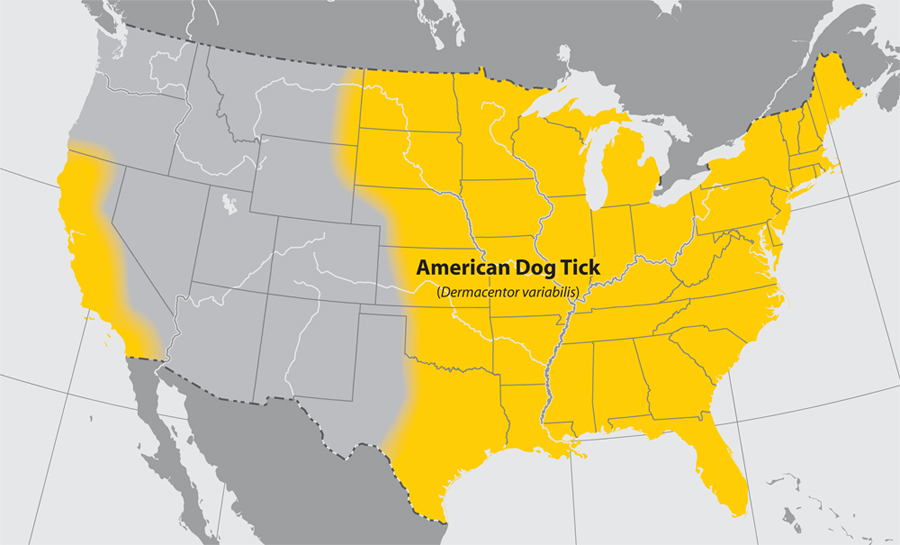

This map is not meant to represent risks for a specific tick-borne disease. Disease transmission for this illness is influenced by multiple factors beyond tick presence alone. This map represents where the american dog tick is found.
For more information, visit the IDPH RMSF webpage.
Preventing tick bites
Ticks are generally found near the ground in brushy or wooded areas. Ticks cannot jump or fly. Instead, these insects climb tall grasses or shrubs and wait for a potential host to brush against them. When this happens, they climb onto the host and seek a place on the skin for attachment.
Tick prevention for wooded or brushy areas:
- Walk in the center of trails
- Wear insect repellent containing DEET
- Wear permethrin-treated clothing
- Treat dogs for ticks
- Check for yourself, gear, and pets for ticks after activities in these risky areas
- Shower as soon as possible after coming inside from outdoors
Tick removal
- Use fine-tipped tweezers to grasp the tick as close to the skin’s surface as possible.
- Pull upward with steady, even pressure. Don’t twist or jerk the tick; this can cause the tick’s mouth parts to break off and remain in the skin. If this happens, remove the mouth parts with clean tweezers.
- After removing the tick, thoroughly clean the bite area and your hands with rubbing alcohol, an iodine scrub, or soap and water.
- Dispose of a live tick by submersing it in alcohol, placing it in a sealed bag/container, wrapping it tightly in tape, or flushing it down the toilet. Never crush a tick with your fingers.
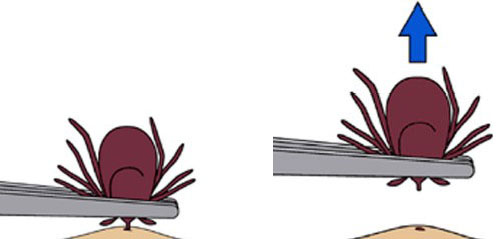
Tickborne Diseases Brochure
The Tick-borne Disease brochure is available by completing this order form.
Current Report
Archived Surveillance Data